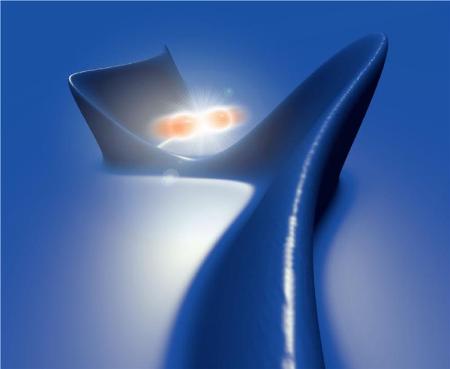Dec 4 2012
With their ultra short X-ray flashes, free-electron lasers offer the opportunity to film atoms in motion in complicated molecules and in the course of chemical reactions. However, for monitoring this motion, the arrival time and the temporal profile of the pulses which periodically illuminate the system, must be precisely known.
 An electromagnetic field accelerates photoelectrons emitted from neon atoms irradiated by an X-ray free-electron laser. In this way, the X-ray pulse temporal profile and arrival time are uniquely retrieved on a pulse to-pulse basis with femtosecond precision. Credit: Jörg Harms/MPSD at CFEL
An electromagnetic field accelerates photoelectrons emitted from neon atoms irradiated by an X-ray free-electron laser. In this way, the X-ray pulse temporal profile and arrival time are uniquely retrieved on a pulse to-pulse basis with femtosecond precision. Credit: Jörg Harms/MPSD at CFEL
An international team of scientists has now developed a measurement technique that provides complete temporal characterization of individual FEL (free-electron laser) pulses at DESY's soft-X-ray free-electron laser, named FLASH. The team, led by Adrian Cavalieri from the Center for Free-Electron Laser Science (CFEL) in Hamburg, was able to measure the temporal profile of each X-ray pulse with femtosecond precision (a femtosecond is a quadrillionth of a second). The Ikerbasque Research Professor Andrey Kazansky from Donostia International Physics Center (DIPC) and the University of the Basque Country (UPV/EHU), as well as Nikolay Kabachnik from the Lomonosov State University in Moscow who is a regular visiting fellow at DIPC, were members of the team. The technique developed in this investigation can be implemented at any of the world´s X-ray free-electron lasers, ultimately allowing for most effective utilization of these sources. The results are published in the current issue of the scientific journal Nature Photonics.
X-ray pulses delivered by free-electron lasers provide unique research opportunities, because the pulses are ultra-intense and ultra-short. At FELs trillions of X-ray photons are packed within a single burst – or pulse – which lasts for only several tens of femtoseconds, or even less. However, the precise arrival time and even the temporal profile of the FEL pulse can change dramatically from one pulse to the next. Therefore, to use the FEL to “film” ultrafast dynamical processes, the arrival time of each pulse must be measured to reorder the individual frames or snapshots captured with each individual FEL pulse.
Provided with accurate timing information, femtosecond FEL X-ray pulses are short enough to study atoms in motion, chemical reactions, and phase transitions in materials with time resolution on the femtosecond scale.
With simultaneous measurement of the FEL X-ray pulse profile, it will be possible to go even further, to explore processes that evolve within the X-ray exposure. On these timescales the motion of electrons and electronic state dynamics become significant. Electronic dynamics drive damage processes in biomolecules, which may destroy them before they can be recorded in a crystal clear image.
For their measurements, the team adapted a technique used in attosecond science called “photoelectron streaking” (an attosecond is a thousandth of a femtosecond). Andrey Kazansky, Ikerbasque research Professor at DIPC and UPV/EHU, explains that "the streaking technique permits recording temporal profiles of varying light signals by creating photoelectron bursts and measuring the energy distribution of these electrons". A photoelectron is the electron emitted from matter (gas, solid, liquids) as a consequence of the absorption of a high energy photon. In other words, is the electron that has been kicked out by a photon.
By taking advantage of the ultra-high intensities available at FELs the researchers were able to perform the streaking measurement on a single-shot basis at FLASH. For this, the X-ray flashes were shot through neon gas on their way to their target. Each X-ray pulse ejects a burst of photoelectrons from the noble gas and it turns out that the temporal profile of the photoelectron bursts is a replica of the FEL pulse that ejected them.
Then, a very intense electromagnetic field is used to accelerate or decelerate the photoelectrons, depending on the exact instant of their ejection. The strength of this effect is measured and combining all the information appropriately the temporal profile and arrival time of the individual X-ray pulses from FEL can be obtained with a precision of about 5 femtoseconds.
“Simultaneous measurement of the arrival time and pulse profile, independent of all other FEL parameters, is the key to this technique,” explains Adrian Cavalieri, who is a professor at the University of Hamburg and a group leader in the Max Planck Research Department for Structural Dynamics (MPSD). Until now, no other measurement has provided this complete timing information – yet it is exactly this information that will be crucial for future application of these extremely perspective X-ray light sources.
The FEL pulse characterization measurements presented by the team are made without affecting the FEL beam - only a negligible number of photons is lost for creating photoelectrons. Therefore, they can be applied in any experiment at almost any wavelength. In the immediate future, laser-driven streaking will be used to monitor and maintain the FEL pulse duration at FLASH to study a wide variety of atomic, molecular and solid-state systems. For further experiments, the researchers plan to use these high precision measurements as critical feedback for tailoring and manipulating the X-ray pulse profile.